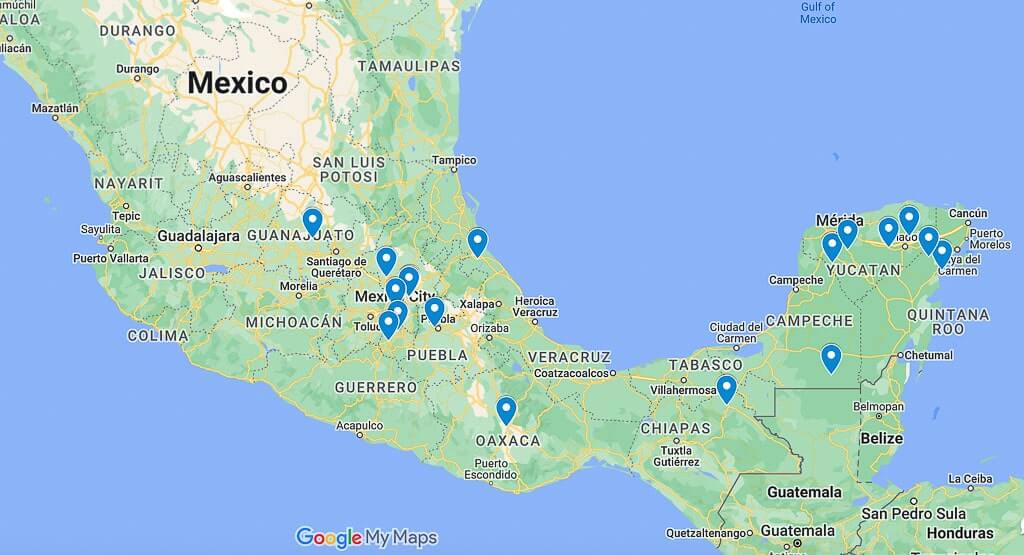Last Updated on January 22, 2024 by Soumya
Planning to visit the most famous pyramids in Mexico? Then, you need this epic Mexico Pyramids Guide!
Visiting the pyramids of Mexico and learning more about the people who built them has been my favorite thing to do in the past few years. It gives me so much pleasure to go back to these ancient ruins again and again. And learn something new every time I visit!
Whether it is marveling at the unique architecture of Chichen Itza, staring wide-eyed at the three towering pyramids of Teotihuacan, getting confused at the Great Pyramid of Cholula, or climbing the Acropolis at Ek Balam for some stunning views, I loved each and every bit of my pyramid travels in Mexico.
Mexico is indeed home to numerous Aztec and Mayan pyramids. However, the country also houses several other Mesoamerican pyramids built by Olmecs, Toltecs, Totonacs, Zapotecs, and the Otomi people!
In this Ultimate Pyramids Guide, I list the 20 most amazing pyramids to visit in Mexico and how to get there. My list is a mix of well-known temples and hidden gems. So, I am hoping that you’ll like this collection and add some pyramids to your Mexico bucket list. 🙂
Please note: This post may contain affiliate links which means I may earn a commission if you make a purchase by clicking a link on this post. This will be at no additional cost to you. Affiliate links help me keep this website up and running. Thanks for your support!
Map of Famous Mexico Pyramids
I have put together an interactive map that’ll give you the locations of pyramids in Mexico. Please click on the map below to access directions to all pyramids.
Top 10 Mexico Pyramids
Chichen Itza – Most Visited Pyramid in Mexico
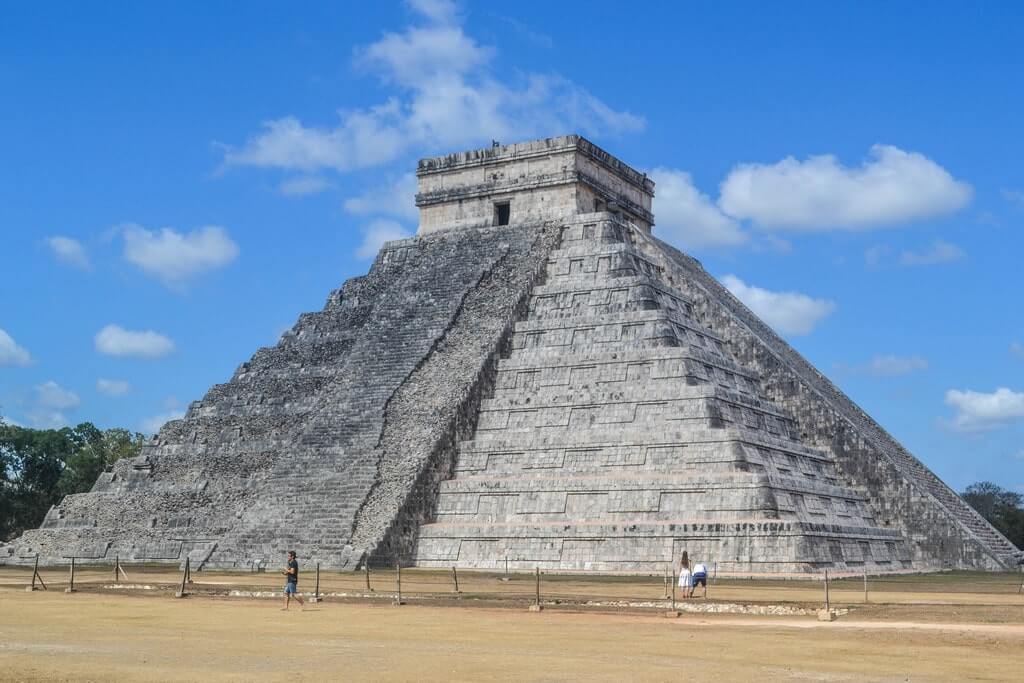
With its mythical charm and grandeur, Chichen Itza is undeniably a crown jewel among Mexico’s pyramids.
This pre-Columbian city, now a UNESCO heritage site and a world wonder, was built by the Maya people. It is believed to have been one of the greatest Mayan centers of the Yucatan peninsula.
The pyramid itself is a marvel of ancient architecture – a testimony to the Mayans’ astronomical skills and their love for precision and geometry.
The legend of Kukulkan, the feathered serpent deity, adds an element of mystique to this historical site. It is said that during the spring and autumnal equinoxes, the shadow cast by the angle of the sun creates a series of triangular shapes that give the illusion of a serpent descending the pyramid. The serpent is believed to be God Kukulkan himself.
Visitors will be awestruck by the dominating presence of El Castillo, also known as the Pyramid of Kukulkan. This four-sided pyramid stands approximately 100 feet high and comprises 365 steps – the exact number of calendar days in a year.
Besides the iconic pyramid, don’t miss the Great Ball Court and the Temple of the Warriors, adorned with impressive columns.
📖 Related Read: If you’re planning to visit the archeological site of Chichen Itza, feel free to check out our Chichen Itza Travel Guide.
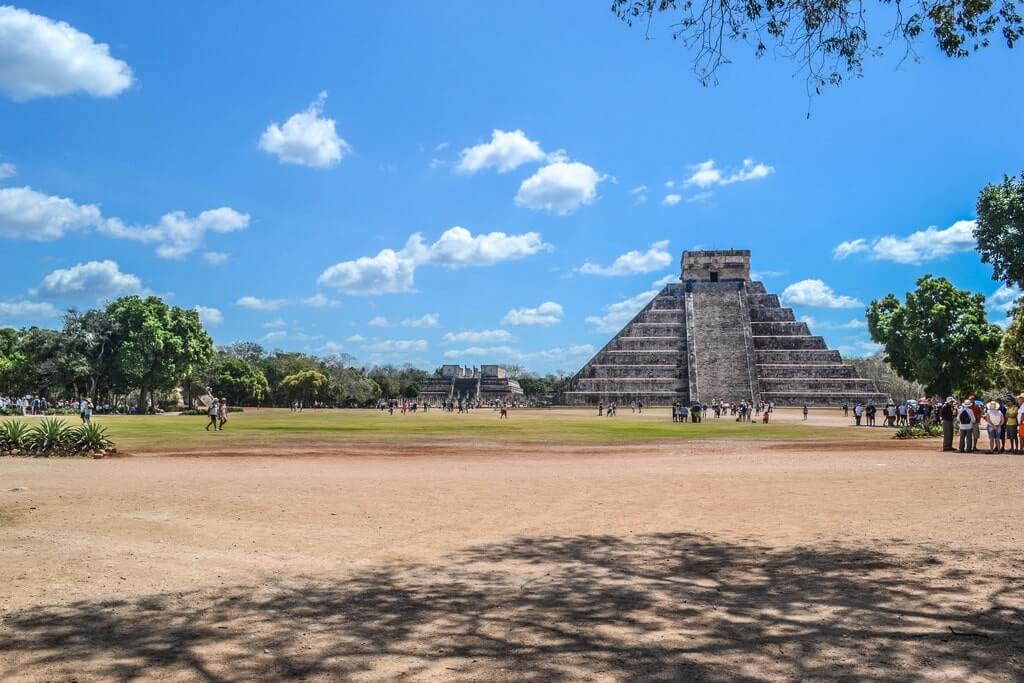
Getting to Chichen Itza Pyramid in Mexico
Chichen Itza is located on the Yucatan Peninsula, one of Mexico’s most popular tourist destinations. Therefore, it is accessible from several major tourist cities.
If you’re based in Cancun, the easiest and most comfortable way to reach Chichen Itza is by bus or a guided tour. ADO, the main bus company, runs convenient services from Cancun to Chichen Itza almost every hour. The ride is around 2.5 to 3 hours, providing a chance to sit back, relax, and take in the scenery.
Guided tours are another popular choice, as they typically include round-trip transportation, a guided visit to the site, and sometimes a stop at a cenote for a refreshing swim. Here’s the best Chichen Itza tour from Cancun that has over 13,000 5-star reviews!
If you don’t mind driving, renting a car can provide the freedom to explore at your own pace. The journey from Cancun via Highway 180D takes a little over two hours. Remember, though, that driving in Mexico can be a unique experience, so ensure you’re comfortable with the road rules and have a reliable navigation system at your disposal.
Pyramid of Sun at Teotihuacan – A Must-Visit Pyramid in Mexico
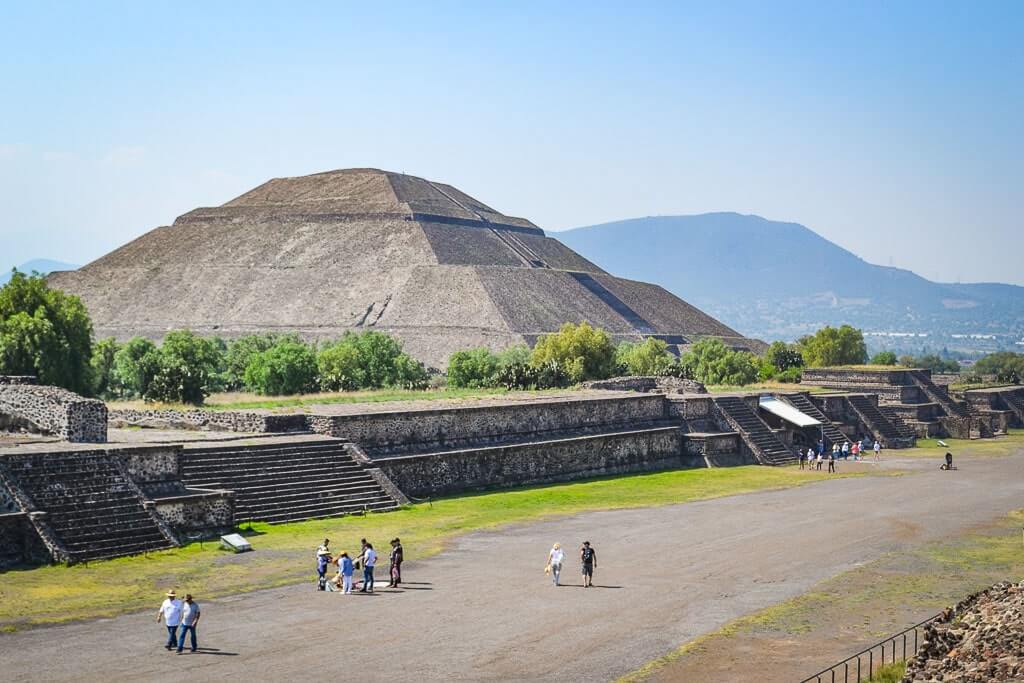
Just a short day trip from Mexico City lies the remarkable archaeological site of Teotihuacan, home to the majestic Pyramid of the Sun. One of Mexico’s most captivating attractions, this pyramid is famous for its historical significance and architectural grandeur.
Constructed around 200 CE, the Pyramid of the Sun is the largest structure in Teotihuacan. Once upon a time, it was believed to be the center of life and spirituality in the ancient city.
This magnificent pyramid stands at an impressive 216 feet, making it one of the largest pyramids in the world. It’s built on a platform foundation, with stairways leading up to a flat top, traditionally used for ceremonies dedicated to the Aztec God of Fire, Huehueteotl. The pyramid is not open for climbing anymore, though it was until 2020.
Excavations have unearthed a myriad of fascinating artifacts at the site, offering glimpses into the city’s rich cultural past. Fragments of mural paintings, pottery, and obsidian tools are among the significant finds.
✦ Pro Tip: If you love ancient ruins and colossal pyramids, then you’ll love our post on the 7 Best Pyramids to visit in Mexico City.
Pyramid of Moon – Second Largest Pyramid at Teotihuacan
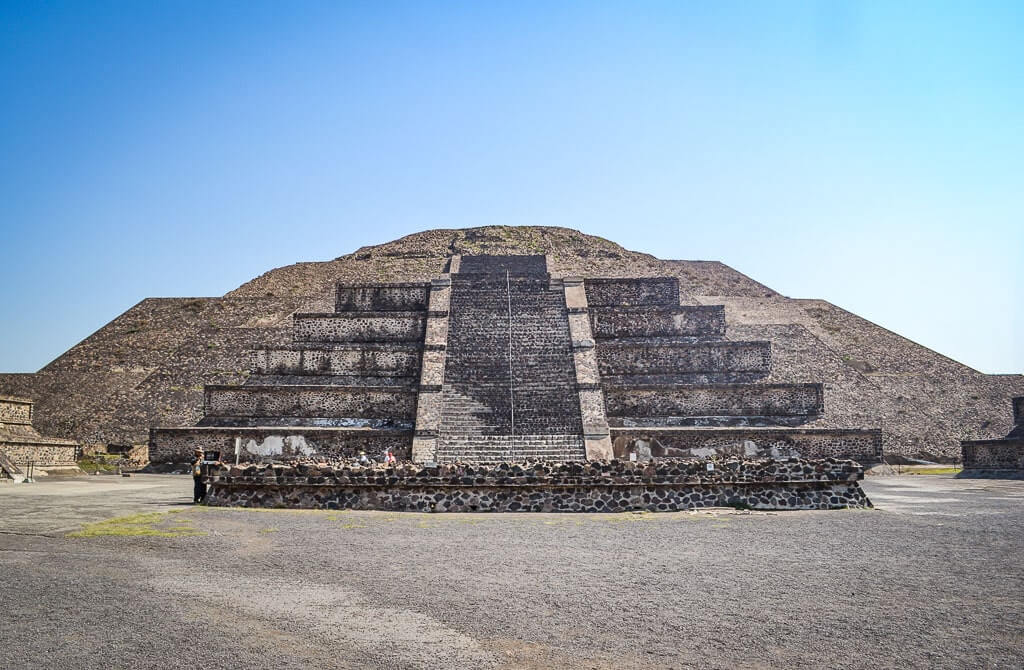
The Pyramid of the Moon, a captivating sight in Teotihuacan, is one of Mexico’s most intriguing pyramids due to its unique history and structure.
Constructed around the same time as the Pyramid of the Sun, the Pyramid of the Moon stands at the northern end of the Avenue of the Dead. Its unique placement suggests that it was a place of high importance in ancient ceremonial practices.
Excavations at the Pyramid of the Moon have uncovered intriguing artifacts that shed light on the lost Teotihuacan civilization. Archeologists have found ceremonial items, pottery, obsidian blades, and even animal and human skeletons, likely sacrifices, buried in the plaza in front of the pyramid.
The Pyramid of the Moon was probably the temple for sacrifice in Teotihuacan.
When visiting, you can observe the intricate layout of the pyramid complex, the Plaza of the Moon, and the smaller pyramids surrounding it.
Earlier visitors could enjoy a panoramic view of Teotihuacan, including the Pyramid of the Sun and the Avenue of the Dead from the top of the pyramid. But climbing is no longer allowed here.
Temple of Quetzalcoatl at Teotihuacan
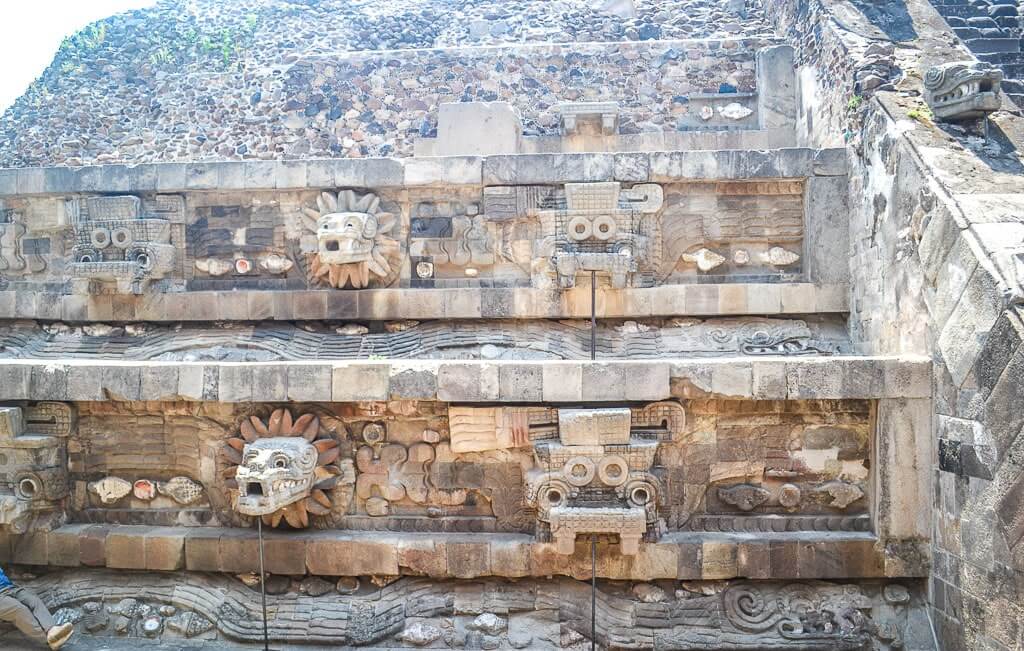
The Temple of Quetzalcoatl, also known as the Feathered Serpent Pyramid, is one of the largest pyramids in Mexico and the third largest in Teotihuacan. It is known for its rich historical significance and the intricate carvings that adorn its edifice.
This iconic temple was constructed during the 2nd century CE during a period of immense prosperity in Teotihuacan. It bears the name of Quetzalcoatl, the Aztec winged deity.
The Temple of Quetzalcoatl sets itself apart with its highly detailed and well-preserved carvings.
The façade is adorned with large, alternating heads of the Feathered Serpent and the Rain God, Tlaloc, each exhibiting their distinct features. The Feathered Serpent is depicted with a collar made of shells, while Tlaloc is easily recognizable with his goggle-like eyes and sharp fangs.
In 2003, archeologists discovered a large tunnel system under the Feathered Serpent Pyramid that turned out to be a burial space for sacrificial victims. Underneath, researchers found several statues of greenstone, obsidian, and crystals.
✦ Pro Tip: Fan of intriguing historical facts? Check out our guide on Interesting Facts about Teotihuacan, one of the most popular posts on the blog.
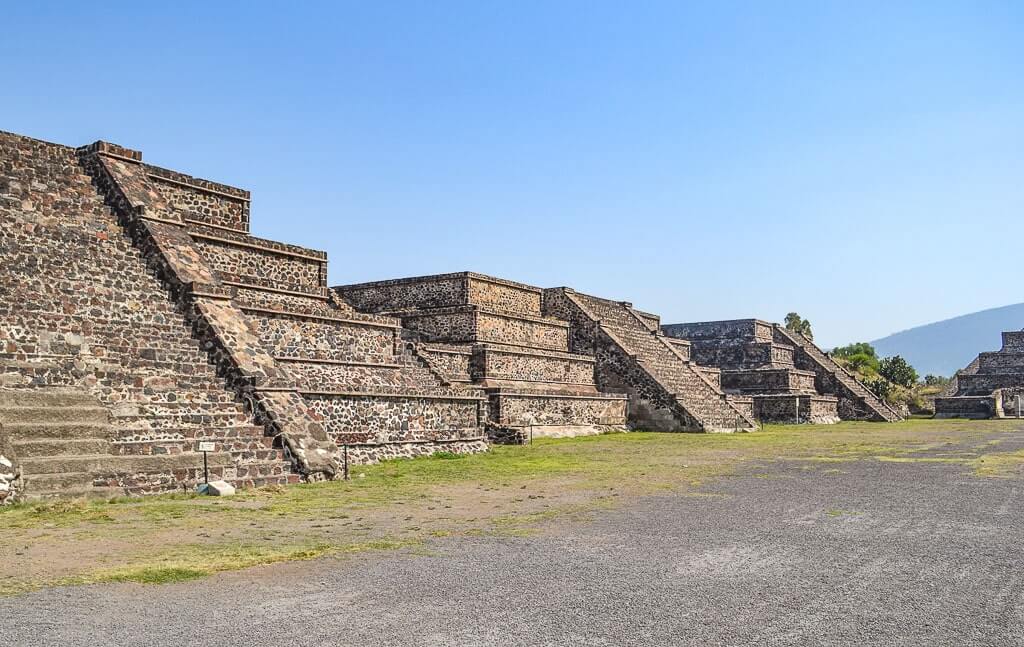
Getting to the Teotihuacan Pyramids from Mexico City
To get to Teotihuacan from Mexico City, you can take a bus from the Autobuses del Norte station. The journey takes around an hour. Buses run regularly throughout the day. Once you reach the Teotihuacan bus station, it’s a short walk to the archaeological site.
Alternatively, you can opt for a guided tour or a taxi which can take you directly to the site. Hot air balloon tours over the Teotihuacan pyramids + time to explore the ruins on your own are vastly popular.
We tried this balloon tour by Volare Balloons, one of the highest rated in the market, and can absolutely vouch for the quality. Or you can try this highly-recommended Teotihuacan Archeology Tour for an in-depth understanding of the history and culture of the lost Teotihuacan civilization.
If you’re driving, take the highway towards San Juan Teotihuacan. On-site parking is available for a small fee.
Remember to wear comfortable shoes as the site is expansive and involves a fair bit of walking.
✦ Pro Tip: Planning to visit the Pyramids of Teotihuacan? Check out our complete guide on how to visit Teotihuacan from Mexico City.
Great Pyramid of Cholula
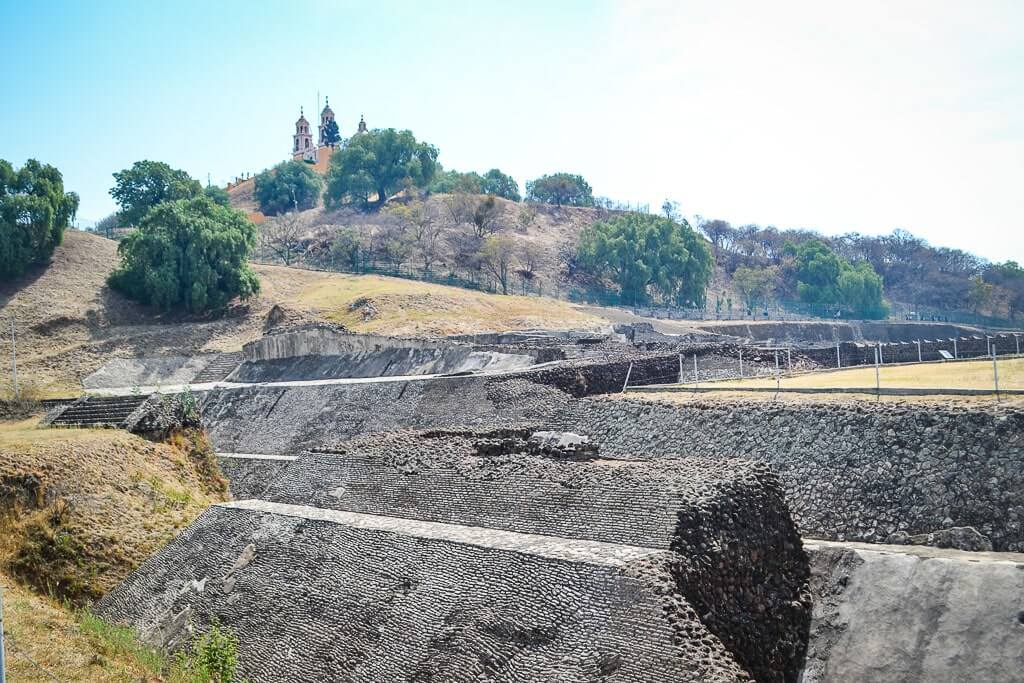
The Great Pyramid of Cholula, also known as Tlachihualtepetl, is another iconic pyramid in Mexico that totally deserves your attention. This is the largest pyramid in the world by volume, even bigger than the Great Pyramid of Giza in Egypt.
Interestingly, the Great Pyramid of Cholula is often mistaken for a hill due to its overgrown vegetation. After the fall of the Toltecs, the pyramid was abandoned, eventually becoming overgrown with local flora. This gave it the appearance of a natural hill. This guise likely saved it from destruction during the Spanish conquest.
The Cholula Pyramid was built in four stages over many centuries. The Olmecs first constructed it in the 3rd century BCE and the Toltecs added the final layer in the 9th century CE.
As you explore the Cholula archeological site, be sure to notice the myriad of buildings and platforms that dot the complex. The highlights include a large Olmec head and a mural panel depicting drinkers of Pulque, a traditional Poblano drink.
Stroll through the labyrinthine network of tunnels running through the pyramid that offer a glimpse into the pyramid’s layered construction. [Closed since the COVID-19 pandemic but hope that it opens soon.]
On the top of the pyramid, you can find the Nuestra Señora de los Remedios church, built by the Spanish in the 16th century. From here you can enjoy spectacular panoramic views of the city of Cholula and the surrounding volcanoes.
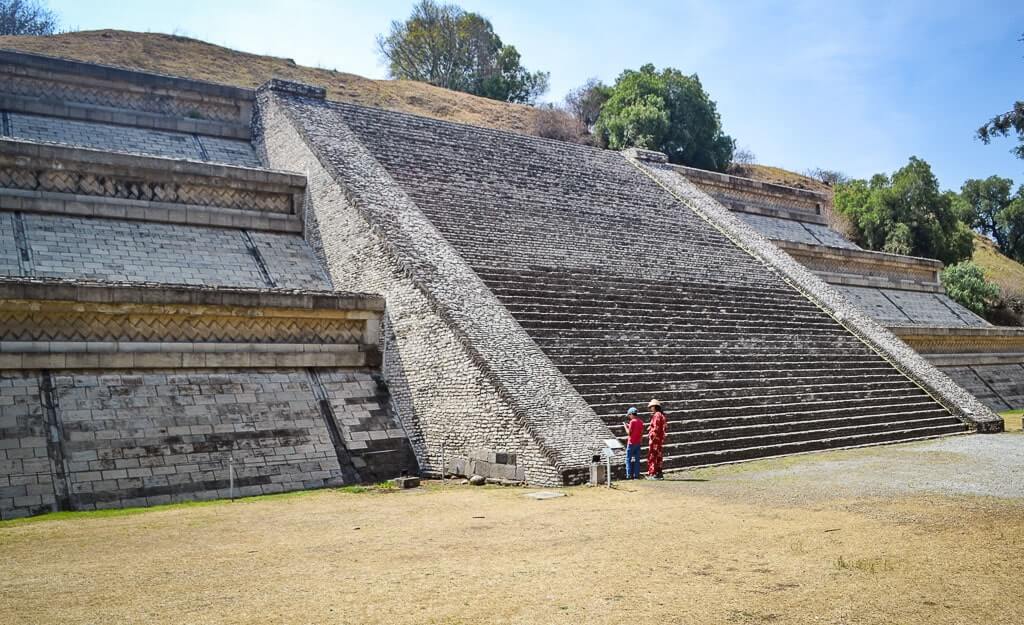
Getting to the Great Pyramid of Cholula
The best way to reach the Great Pyramid of Cholula is by taking a taxi or tour from Puebla. Here’s a great private tour that takes you on an immersive excursion of the pyramid and the surrounding archeological zone.
If you wish to see Cholula on a day trip from Mexico City, then check out this highly recommended full-day tour.
You can also take a bus from Puebla City but the schedules are a little erratic. Have a look at my Cholula travel guide to figure out bus routes.
Pyramid of the Magician Uxmal
The Pyramid of the Magician at Uxmal (pronounced oosh-mahl), a UNESCO World Heritage Site, is indeed one of Mexico’s greatest pyramids.
Known locally as “El Adivino,” this pyramid is unique due to its oval-shaped base, unlike the more common rectangular or square bases seen in most Mesoamerican pyramids.
Built in the Puuc style of architecture, the archeological site of Uxmal is a grand ensemble of decorative facades, intricate stone carvings, and elegant archways.
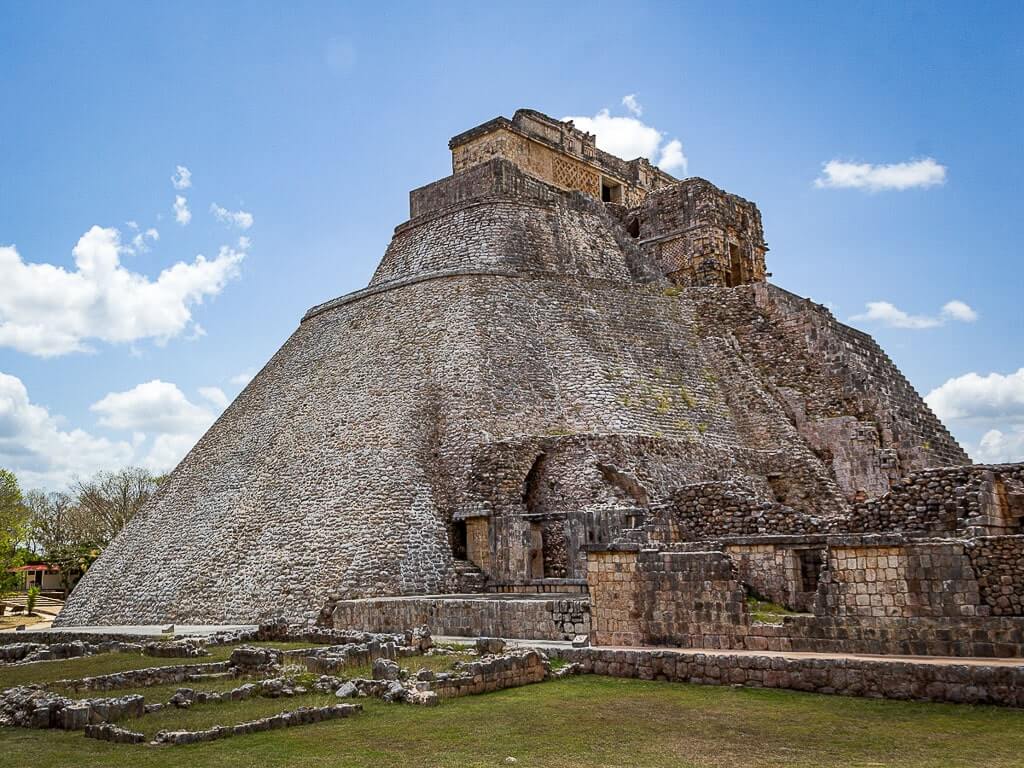
As for history, the Pyramid of the Magician has a mythical aura surrounding its construction. Legend suggests it was built overnight by a dwarf who hatched from an egg, using his magical powers. In reality, however, the pyramid was built in five stages, with each stage corresponding to a different period from the 6th to the 10th century CE.
When visiting the site, you’ll be captivated by the central pyramid’s commanding presence, rising about 115 feet high. Its impressive western stairway is lined with masks of the rain god, Chaac, showcasing the Mayans’ reverence for this deity.
The pyramid is part of a larger complex, including the Nunnery Quadrangle and the Governor’s Palace. Both offer splendid examples of Puuc architecture.
Getting to Uxmal Pyramid in Mexico
The site is approximately an hour’s drive south of Merida, the capital of Yucatan. If you have your vehicle, you can drive along the well-marked Highway 261.
Alternatively, you can use reliable and inexpensive ADO buses from the ADO Centro Historico TAME bus station in Merida. The buses run a couple of times a day.
Additionally, several tour companies offer day trips to Uxmal, usually in combination with other nearby historical sites. Here’s a great full-day tour from Merida that includes a tour of the ruins, a hacienda visit, and a cenote swim.
Remember, the site opens at 8 a.m., and it’s best to arrive early to beat both the heat and the crowds.
Temple of Inscriptions in Palenque
Palenque (pronounced pah-LEN-keh), an ancient ruin hidden in the lush jungles of the state of Chiapas, is home to some of Mexico’s most fascinating Mayan pyramids.
Once a thriving Mayan city-state, Palenque was abandoned around the 8th century and subsequently reclaimed by the jungle. It wasn’t until the 18th century that its treasures were rediscovered.
One of the most notable structures in Palenque is the Temple of Inscriptions. Built-in the 7th century, this pyramid served as the funerary monument for the ruler Pakal the Great.
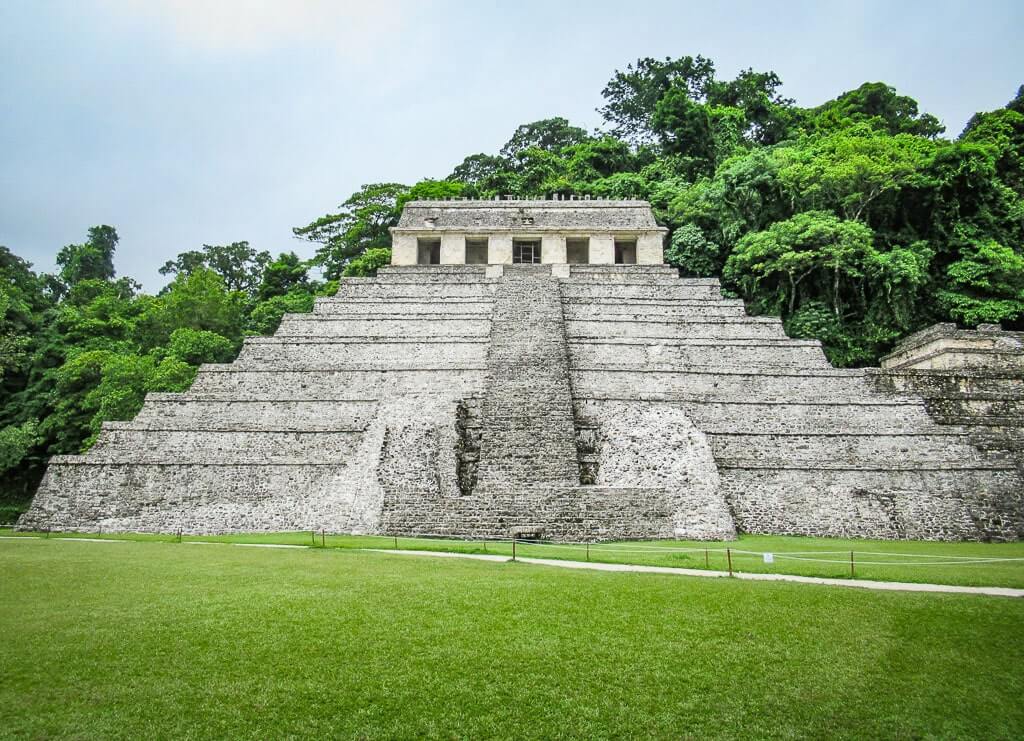
Pakal’s tomb discovered deep within the pyramid is one of the most significant archaeological finds in the Americas. His jade-adorned body, along with intricate carvings and glyphs on the sarcophagus, offer deep insights into the beliefs, culture, and artistic excellence of the ancient Mayan civilization.
You can see a beautiful replica of the tomb at the National Anthropology Museum in Mexico City.
Besides the Temple of Inscriptions, there are other remarkable monuments to explore, including the Palace with its distinctive 4-story observation tower and the Temple of the Cross Complex. These structures reveal the expertise of ancient Mayan astronomers, as they align with specific astronomical phenomena.
Do remember to carry insect repellent though, as the jungle setting can be rife with tiny critters.
Getting to Palenque Pyramids in Mexico
Getting to Palenque is a little tricky because it is tucked away in the southeastern corner of Mexico. The closest operational airport is the Villahermosa Airport (VSA), approximately a two-hour drive away.
If you prefer road journeys, ADO buses run frequently from cities such as Campeche, Merida, and Tulum. The ride offers scenic views of the Mexican countryside.
Once in Palenque City, you can hire a taxi or take a colectivo (shared van) to the archaeological site. The site is around 5 miles from the city, so it’s a relatively short ride.
The Great Pyramid of Calakmul
As you step into the heart of the Calakmul Biosphere Reserve in the Campeche State in southern Mexico, you’ll find one of Mexico’s most fascinating pyramids, the Great Pyramid of Calakmul.
Lost within the dense jungle for centuries, this towering monument was once the centerpiece of one of the most powerful ancient Mayan cities.
Historically, Calakmul played a pivotal role in the Classic Maya period (250 – 900 CE), serving as a significant rival to another mighty city-state, Tikal.
The Great Pyramid is the largest Mayan pyramid in Mexico and one of the most massive ancient structures in the Americas. It stands around 165 feet (50 m) high, with a base covering over 2 hectares. Its body is made up of over 6.5 million cubic meters of rock and fill.
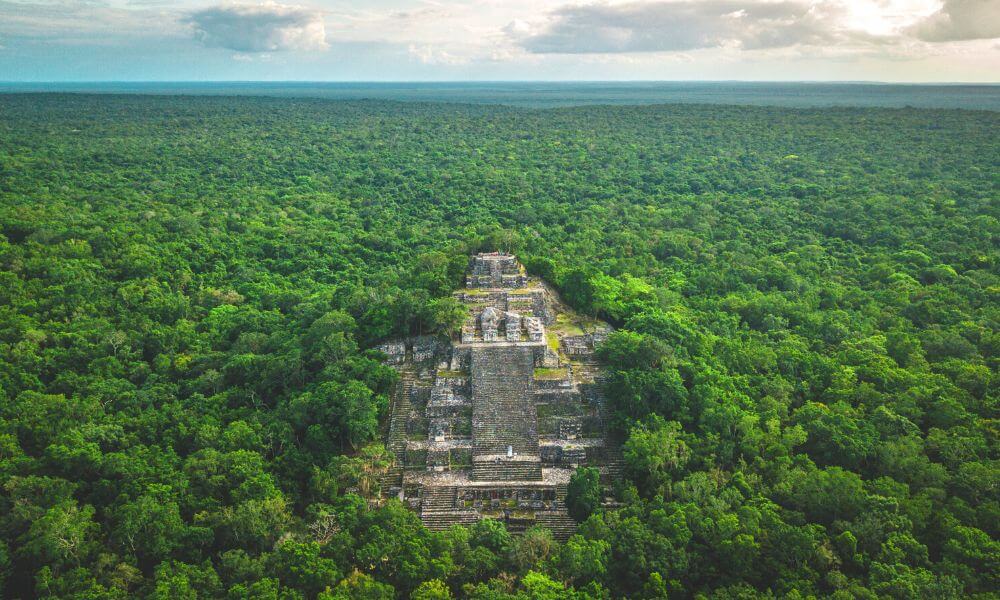
The archaeological exploration of Calakmul has unveiled a trove of Mayan artifacts, including intricately carved friezes, murals, jade masks, and burial sites replete with precious grave goods.
One of the most significant finds is the tomb of a ruler known as Yuknoom the Great, discovered within the Great Pyramid itself. The tomb dates to the 8th century and was filled with offerings, shell jewelry, obsidian blades, ceramics, and a stunning jade mosaic mask. This clearly provides a glimpse into the opulence of the ancient Mayan elite.
Hiking to the top of the Great Pyramid (still open to climbing) offers a breathtaking panorama of the endless sea of green canopy, the roar of howler monkeys echoing in the distance.
The site is also home to several other plazas, palaces, and courtyards. Calakmul was one of the most sprawling palatial complexes in the Mayan world.
Getting to the Great Pyramid in Calakmul
Calakmul Biosphere Reserve is located about two hours by car from the nearest town of Xpujil. It is not the easiest Mexican pyramid to get to.
You can reach Xpujil via a bus from Cancun, Playa del Carmen, or Tulum. From Xpujil, you’ll need to hire a taxi or a local guide with a 4×4 vehicle to reach Calakmul. Signing up for a highly-rated guided tour like this one is helpful.
Alternatively, you can rent a car and drive yourself. The drive into the reserve is long but beautiful, taking you through vast stretches of jungle.
Remember to pack food, water, and insect repellant as facilities are limited once you’re there.
El Castillo: The Seaside Pyramid at Tulum Mexico
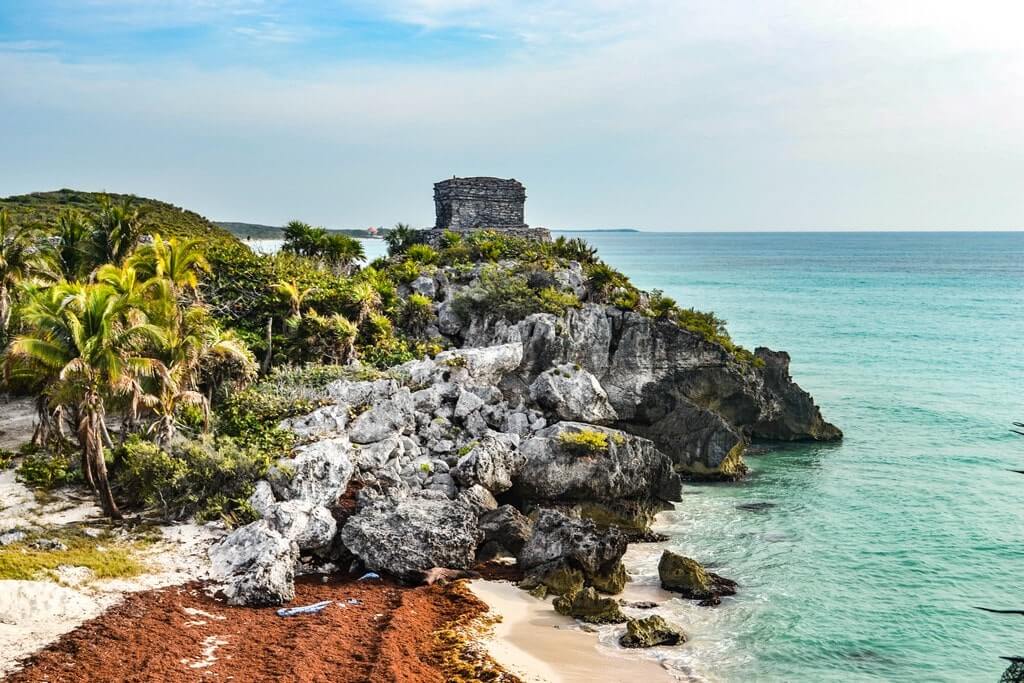
The Tulum ruins, home to one of Mexico’s most iconic Mayan pyramids, are a spectacle unlike any other. That’s because of their stunning location on a cliff overlooking the turquoise Caribbean Sea.
As you must have guessed already, Tulum was a Mayan seaport city. Dating back to the late 13th century, it served as a major trading hub for obsidian and jade.
The pyramid known as “El Castillo” is the most striking structure here. It was likely used as both a temple and a lighthouse for incoming trade ships.
As you explore this walled city, you’ll come across several other remnants of ancient Mayan life, including smaller shrines and the ruins of a palace.
The Temple of the Frescoes showcases beautiful murals and stucco figures. Another important monument is the Temple of the Descending God, featuring an elaborate carving of a winged figure descending from the heavens.
When planning your visit, be sure to bring your swimwear. After a day of exploring the ruins, nothing beats a cool dip in the crystal-clear waters beneath the cliffs of Tulum.
Getting to the Tulum Ruins in Mexico
If you’re traveling from Cancun, you can take the ADO bus from Centro bus station, which runs direct services to Tulum multiple times a day. The journey takes roughly 2.5 hours.
Alternatively, if you’re staying in Playa del Carmen, colectivos (shared vans) are a popular and inexpensive mode of transport. They run frequently along the main highway, taking approximately 45 minutes to reach Tulum.
Here are a couple of highly-recommended tours if you’re looking for options
- Tulum Ruins, Reef Snorkeling, Cenotes and Caves Tour from Playa del Carmen
- Tulum Day Trip with Cenote Swim from Cancun
If you prefer the convenience and flexibility of driving, rent a car and explore the ruins at your own pace. Tulum is approximately a two-hour drive from Cancun and just under an hour from Playa del Carmen. Parking is available on-site.
Regardless of how you choose to get there, remember to arrive early to avoid the heat and the crowds. The ruins open at 8:00 am, and it’s best to be there when the doors open.
Pyramid of the Niches in El Tajin
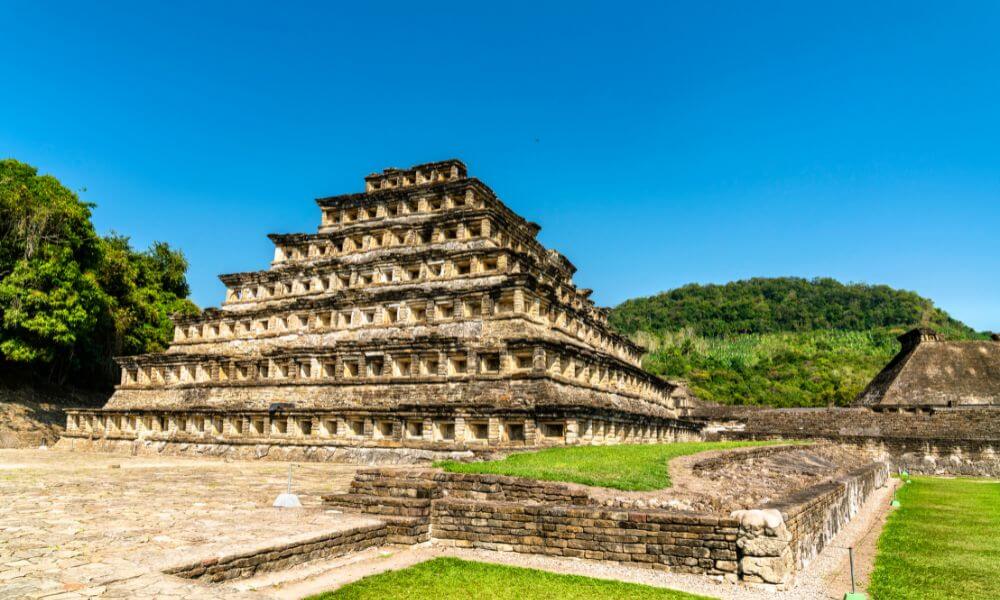
The Pyramid of the Niches in El Tajin is undeniably one of Mexico’s most intriguing pyramids for its unique architecture and historical significance.
Constructed by the Totonac people, this pre-Hispanic archaeological site, also listed on the UNESCO world heritage list, is known for its intricately carved friezes and columns.
The Pyramid of the Niches earned its name from its unique design — 365 rectangular niches built into the four sides of the façade. These niches are thought to represent the solar year. El Tajin is the only place in Mexico where you’ll see this unique niche architectural style.
Apart from the magnificent pyramid which is 60 feet tall, the archeological site at El Tajin has many other attractions including the Arroyo Group of monuments, North and South Ball Courts, several smaller pyramids, and an on-site museum.
Getting to the Niches Pyramid in El Tajin
The site is located near the town of Papantla in the Mexican state of Veracruz.
If you’re traveling from Mexico City, you can take a bus that will take you to Papantla via Poza Rica in approximately 6 to 7 hours.
More Mayan Pyramids in Mexico
The Acropolis at Ek Balam: Mexico’s Hidden Pyramid
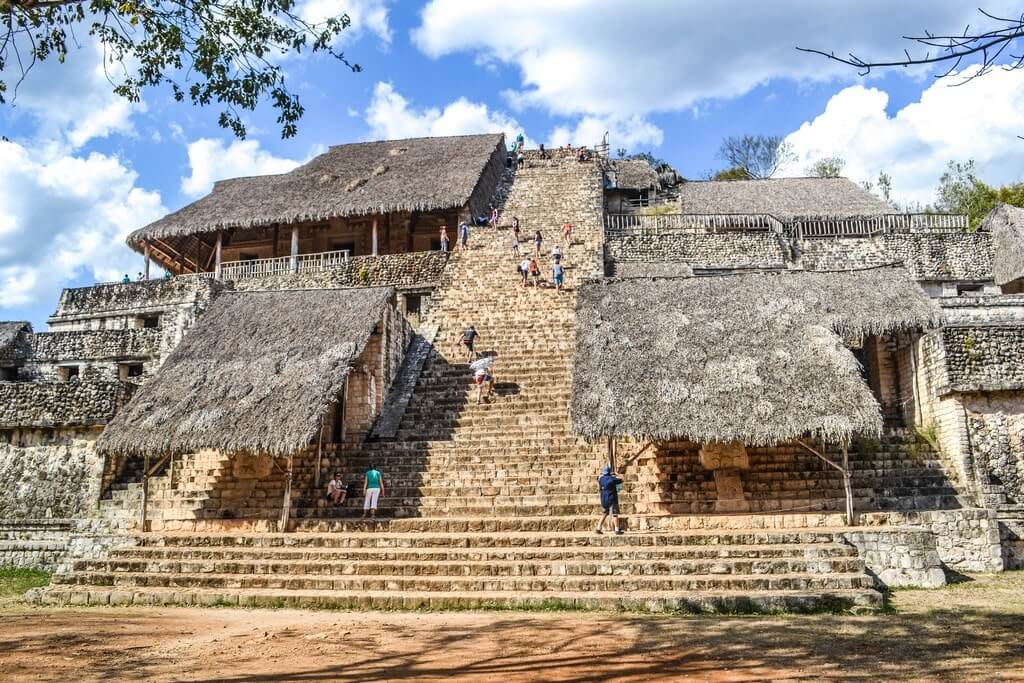
Ek Balam, which translates to “Black Jaguar” in the Mayan language, is home to one of the most impressive yet less-visited pyramids in Mexico. It is called the Acropolis, a massive pyramid that stands 96 feet tall.
What makes Ek Balam special is the remarkable preservation of the pyramid and the unique artifacts around it.
The entrance of the pyramid is adorned with intricate stucco reliefs, depicting mythical and religious Mayan scenes. This includes a jaw-dropping depiction of the Mayan Underworld’s entrance flanked by the open jaws of a monster.
Ek Balam was a prosperous city under the rule of King Ukit Kan Le’k Tok’, whose tomb was discovered inside the Acropolis. The tomb was decorated with ornate carvings and held many funerary items.
Visitors to Ek Balam can also climb to the top of the pyramid, unlike many other pyramids in the Yucatan. The view from the top is breathtaking, overlooking the dense jungle surrounding the site and other structures within Ek Balam.
The Oval Palace and the Twin Pyramids are other must-see structures in Ek Balam. There’s also a secret cenote Xcanche (requires a separate ticket) inside the archeological park where you can go for a quick swim.
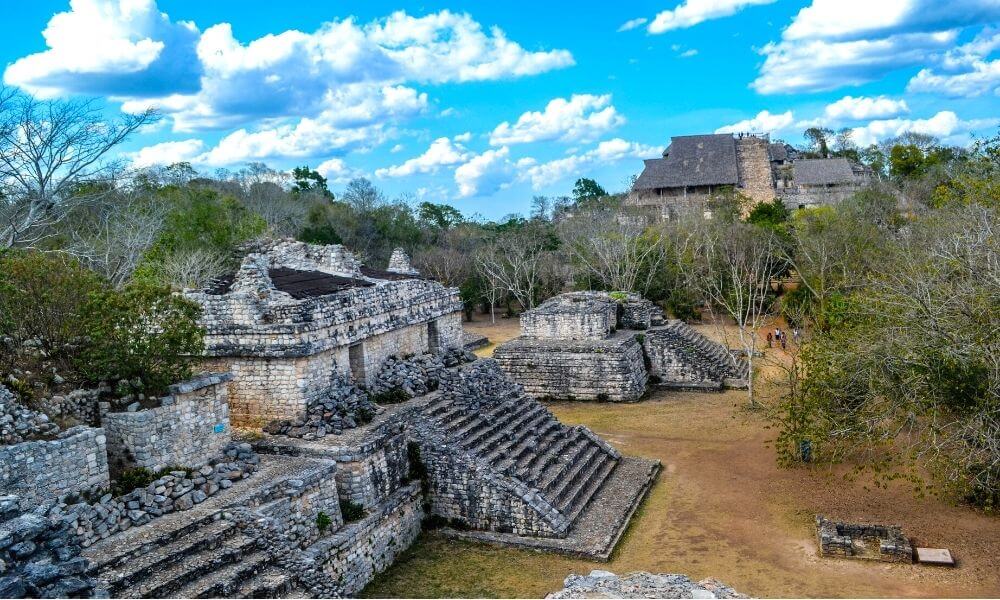
Getting to Ek Balam Pyramids in Mexico
The archaeological site of Ek Balam is located approximately 12 miles north of the charming city of Valladolid in the Yucatan Peninsula.
Numerous local tour operators offer day trips to Ek Balam, usually paired with a visit to the nearby cenotes. Here’s a great tour from Valladolid that combines the Mayan site of Ek Balam and the Rio Lagartos nature reserve.
If you prefer to travel independently, public transportation is available from Valladolid. Colectivos (shared taxis) run regularly from Valladolid to Ek Balam throughout the day. Alternatively, you can rent a car for a more comfortable and flexible journey.
If you’re traveling from Cancun, it’s about a two-hour drive to the west. Booking a guided tour from Cancun that combines Ek Balam and Chichen Itza is easily the most relaxing way to see these beautiful Mayan pyramids in Mexico.
Do remember to pack sun protection, plenty of water, and comfortable shoes for climbing the pyramid. With its less crowded nature and extraordinary structures, Ek Balam guarantees an unforgettable experience for all history and nature enthusiasts.
📖 Related Read: Want to visit Ek Balam? Check out our complete Ek Balam travel guide.
Nohoch Mul Pyramids at Coba
Coba, home to the Nohoch Mul temple pyramids, is one of Mexico’s most captivating archaeological sites.
Steeped in history, Coba was once a thriving city. It was the epicenter of the ancient Maya civilization between 600 and 900 CE.
Spread over a vast area, this ancient city was a complex network of causeways called sakbe’ob connecting clusters of residential areas to the central pyramid.
Ixmoja is the tallest temple pyramid in Coba. What distinguishes Ixmoja from others is its incredible height. Standing at 137 feet, it’s one of the tallest pyramids in the Yucatan Peninsula.
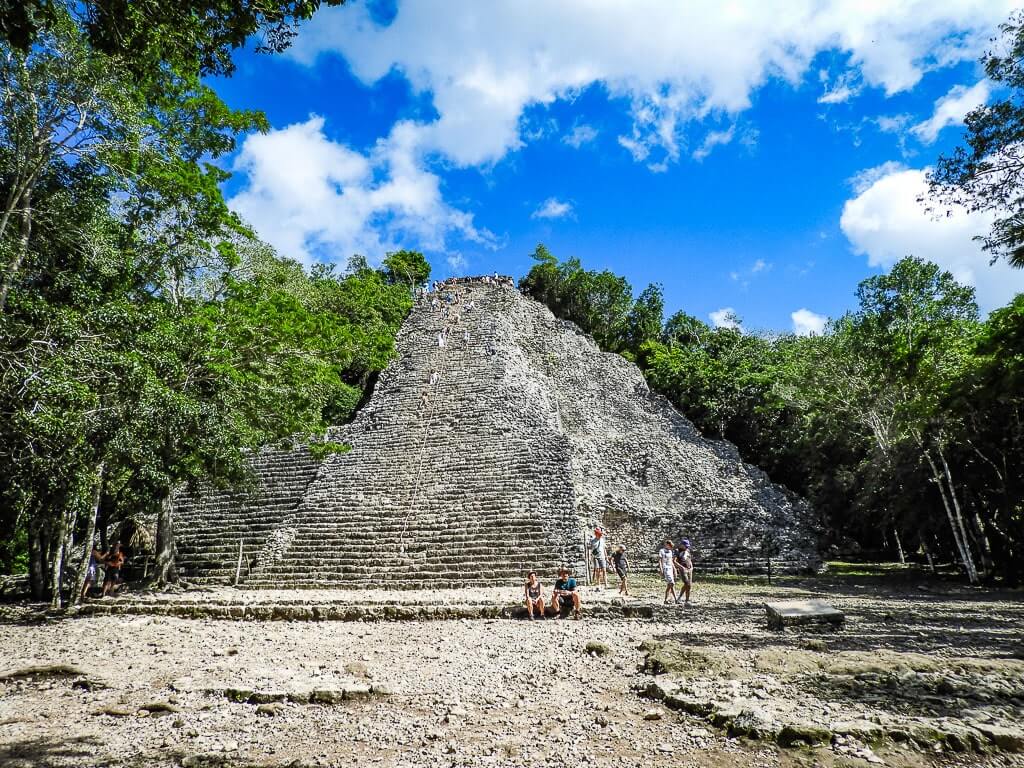
The view from the top is absolutely rewarding though you can no longer climb the Coba Pyramid.
In the archeological zone, you’ll find other intriguing structures such as the Ball Court, known for the ceremonial ball game played by the ancient Maya. The Stelae, stone monuments etched with significant hieroglyphic texts, are also worth exploring, as they provide insights into the Maya culture and history.
Getting to Coba Pyramids in Mexico
The easiest way to get to Coba from anywhere in Riviera Maya is by renting a car. The drive from Cancun to Coba takes approximately two hours along a well-marked highway.
Public transport is not that convenient and you’ll need to change a couple of buses to get to Coba from Cancun.
However, the easiest and perhaps the most informative way to visit Coba is to book an organized tour, which typically includes transportation, a guided tour of the site, and sometimes even a few extra stops at other points of interest along the way. Check out this guided, archeological tour of Coba and Tulum that has rave reviews.
The Temple of Kukulkan at Mayapan
The Temple of Kukulkan at Mayapan, often referred to as “El Castillo”, is one of Mexico’s most fascinating pyramids in the Yucatan.
The ancient Mayan city of Mayapan was a relatively newer settlement that rose to power between 1220 and 1400 CE and was probably the last capital of the Mayans. It was a major trading center with its trading arms extending as far as Central Mexico and Guatemalan Highlands.
The Kukulkan Pyramid is the tallest structure at the historic site. It owes its name to Kukulkan, the Feathered Serpent deity of the Maya. Honestly, it looks like a smaller version of the Kukulkan Pyramid at Chichen Itza.
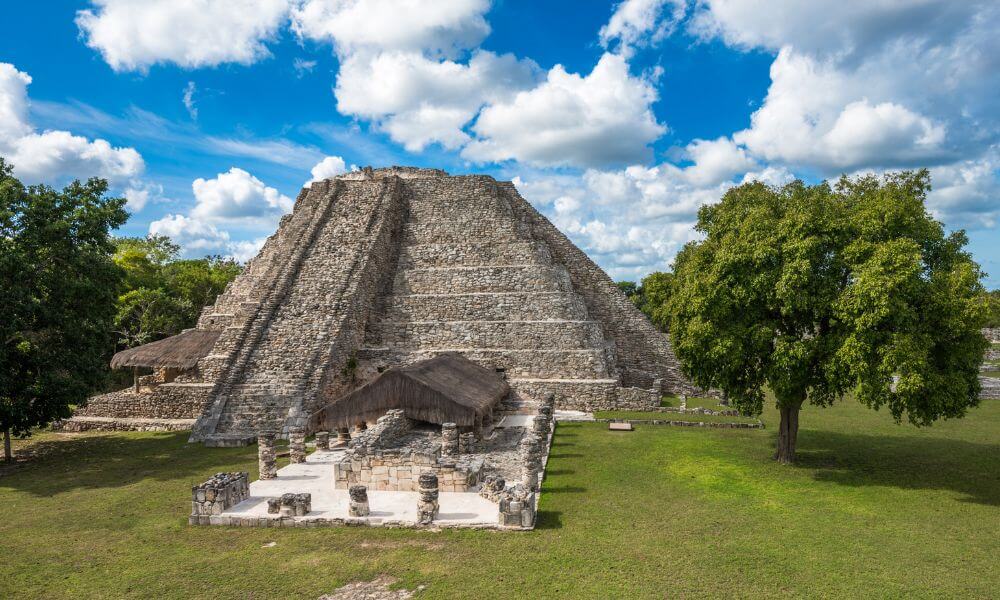
The pyramid is essentially a four-sided structure, with each side having a staircase leading to the temple’s top. The number of stairs adds up to 260 = the number of days in the Tzolkin – the Mayan Sacred Calendar.
Visitors to Mayapan can explore the surrounding archaeological ruins, which once served as a major political and cultural center of the Mayan civilization. Highlights include a columned patio called the Hall of the Kings, the Dancers Platform, and the Room of the Paintings.
Getting to Mayapan Pyramid in Mexico
The easiest way to get to Mayapan is by driving or taking a bus from Merida.
Grab a bus from the bus stop on Calle 67 in Merida and head to Telchaquillo, the town closest to the ruins. The bus journey takes around 2 hours.
Or rent a car, enter the “Archaeological Site of Mayapan” in Google Maps, and get there in an hour.
More Aztec Pyramids in Mexico
Templo Mayor in Downtown Mexico City
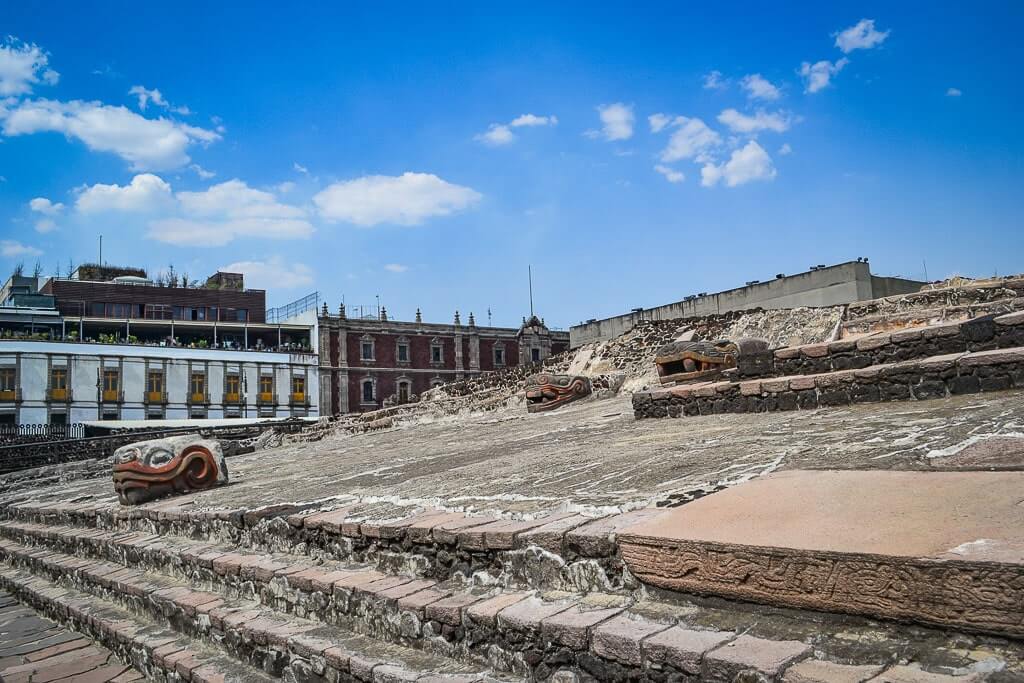
Located in the heart of Mexico City, Templo Mayor is another marvel among Mexico’s pyramids.
Templo Mayor was the primary temple of the Aztec or Mexica people. Its construction began around 1325. The Aztec pyramid underwent seven expansion phases before the Spanish arrived in 1519 and destroyed it completely.
Templo Mayor was dedicated to two deities – Huitzilopochtli, the god of war, and Tlaloc, the god of rain and agriculture. It was a rare example of the dual pyramid structure that evolved during the Aztec era.
The temple was at the center of the Aztec capital city of Tenochtitlán, right where the Historic Center stands today.
Archaeological explorations of Templo Mayor have uncovered a treasure trove of Aztec artifacts. Thousands of objects like ceremonial daggers, jade beads, pottery, and a remarkable monolithic sculpture of Coyolxauhqui, the moon goddess, provide insights into the vibrant and often brutal Aztec culture.
Visitors today can explore the ruins of this iconic temple, which include various platforms, serpent balustrades, sacrificial stones, and a creepy skull rack. Adjacent to the ruins lies the Templo Mayor Museum, where artifacts excavated from the site are on display.
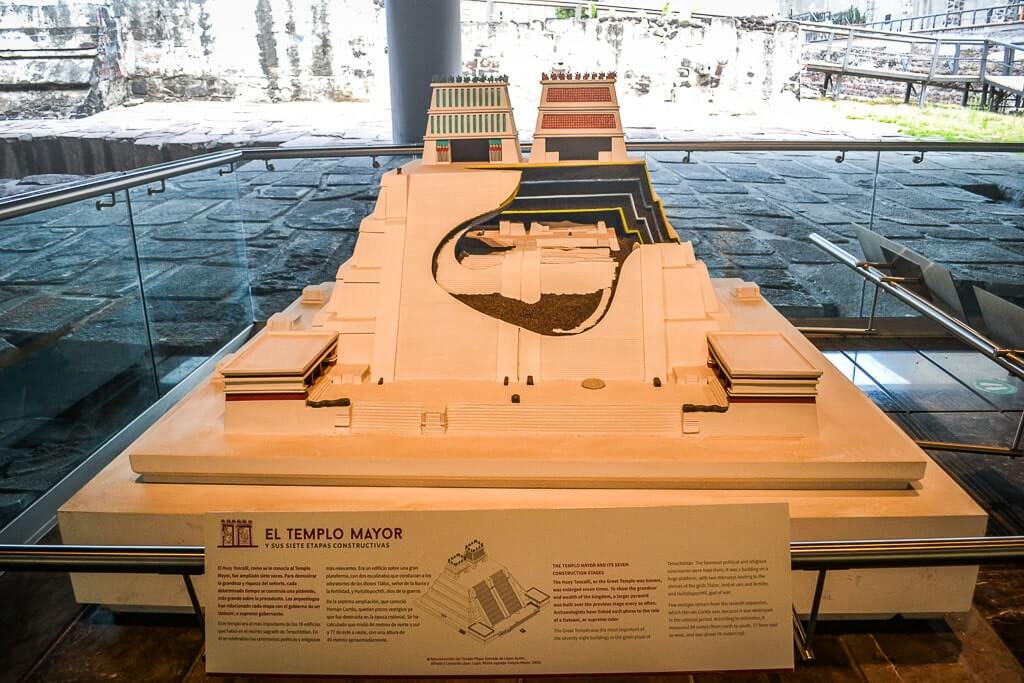
Getting to the Templo Mayor Pyramid in Mexico City
If you’re in downtown Mexico City, you can simply walk over to the site.
For those staying outside the city center, taking the metro is a convenient option. The closest station, Zócalo, is just a short walk away from the temple.
Alternatively, taxis and Uber are readily available throughout the city, making it easy to reach Templo Mayor from anywhere in Mexico City.
✦ Pro Tip: If you’re planning to visit the ruins of Templo Mayor, then do check out our guide for the Best Things to do in the Historic Center of Mexico City for ideas on what to do after the pyramid visit.
Tlatelolco Pyramid in Mexico City
The Tlatelolco Pyramid was originally built by the Tlatelolca, a subgroup of the Aztecs, the pyramid saw multiple periods of construction and modification. Each generation left its mark, with the result being a fascinating mix of architectural styles and influences.
Located in the heart of Mexico City, Tlatelolco was once a separate city-state that rivaled the Aztec capital of Tenochtitlán in size and importance. Eventually, Tenochtitlan defeated Tlatelolco in war and annexed it into the Aztec territory.
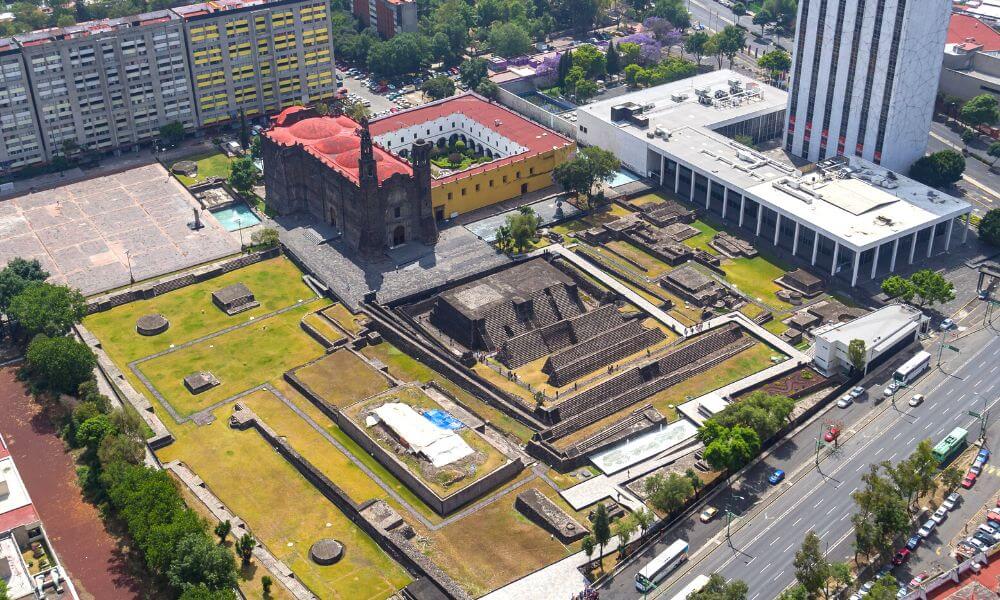
At the archaeological site, visitors can marvel at the majesty of the Pyramid or Major Temple. Other highlights include the ruins of the palace, Temple of Paintings, Calendar Temple, and the burial site of the Tlatelolco Lovers.
The location of the archeological site at the Plaza of Three Cultures is interesting for its representation of pre-Hispanic, Spanish, and independent Mexican periods.
In many ways, the Tlatelolco historic site is a mirror reflecting the past and present of Mexico and a blend of diverse cultural epochs and architectural styles.
Getting to Tlatelolco Ruins in Mexico City
The most convenient method is by metro. Hop on the metro line 3 and get off at the Tlatelolco station. From there, it’s a short walk to the plaza where the pyramid is located.
This guided tour that includes the Mexican pyramids of Teotihuacan and Tlatelolco is a great choice too.
El Tepozteco Pyramid
El Tepozteco is undoubtedly one of Mexico’s most mysterious pyramids, primarily due to its dedication to a god of alcohol. Its spectacular location atop a cliff in the Tepozteco Mountain near the town of Tepoztlan just adds to the mystical allure.
Built-in honor of Tepoztecatl, the Aztec god of pulque, a traditional fermented drink, El Tepozteco Pyramid adds an element of mystique to the rugged mountain landscape.
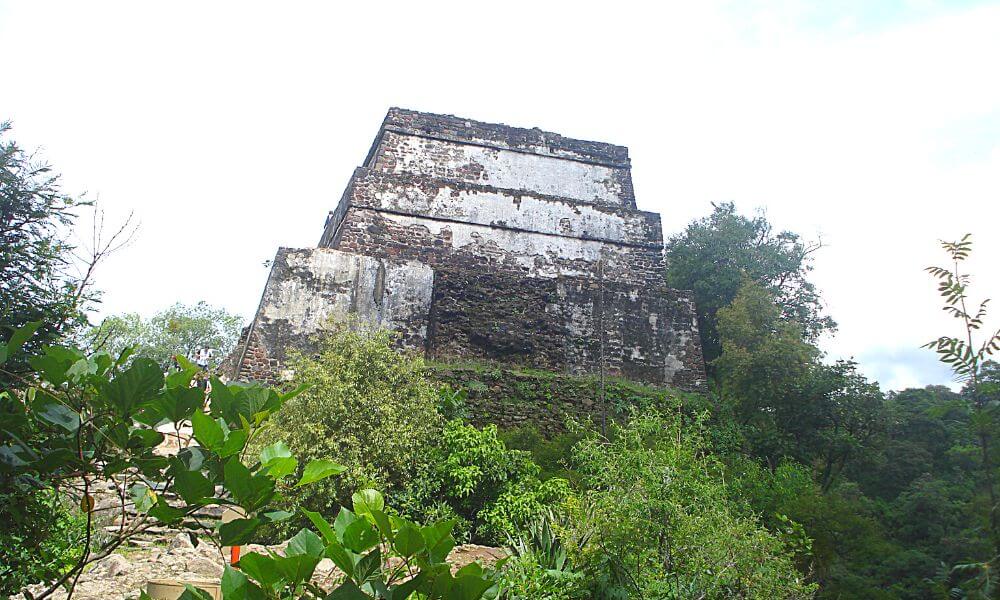
The pyramid’s history is shrouded in mystery, but it’s believed to have been built by the Aztecs around 1100 – 1150 CE. For centuries, this sacred place has been a pilgrimage site for believers seeking the blessings of the deity. Devotees from as far as Guatemala thronged this tiny shrine.
Today, the Tepozteco Pyramid boasts an impressive view of the surrounding valleys and the town below, making it a true gem among Mexico’s ancient ruins.
Visitors to El Tepozteco will find a single temple at the top, which despite erosion and time, still stands proudly. Steep stairs lead up to the temple, and along the way, you’ll be spoiled with lush vegetation, occasional wildlife sightings, and ultimately, panoramic vistas from the top. The climb, while intense, is worth every effort when you reach the summit.
Getting to El Tepozteco Pyramid in Mexico
El Tepozteco is probably the most adventure-friendly pyramid on this ancient pyramids of Mexico list.
The hiking path to the pyramid starts as a cobblestone road winding through the town of Tepoztlan, eventually turning into a dirt trail as it ascends into the mountain. The trail is well-marked, but it’s a good idea to start early in the morning to avoid the afternoon heat. The hike typically takes about 1 to 2 hours depending on your fitness level.
The hike to the top is steep and can be challenging. Remember to pack a hat, sunscreen, and plenty of water, as there are no facilities or vendors along the trail. Put on your best hiking shoes, pack some water, and prepare for a memorable ascent into this hidden pyramid in Mexico.
Other Mesoamerican Pyramids in Mexico
Feathered Serpent Pyramid at Xochicalco
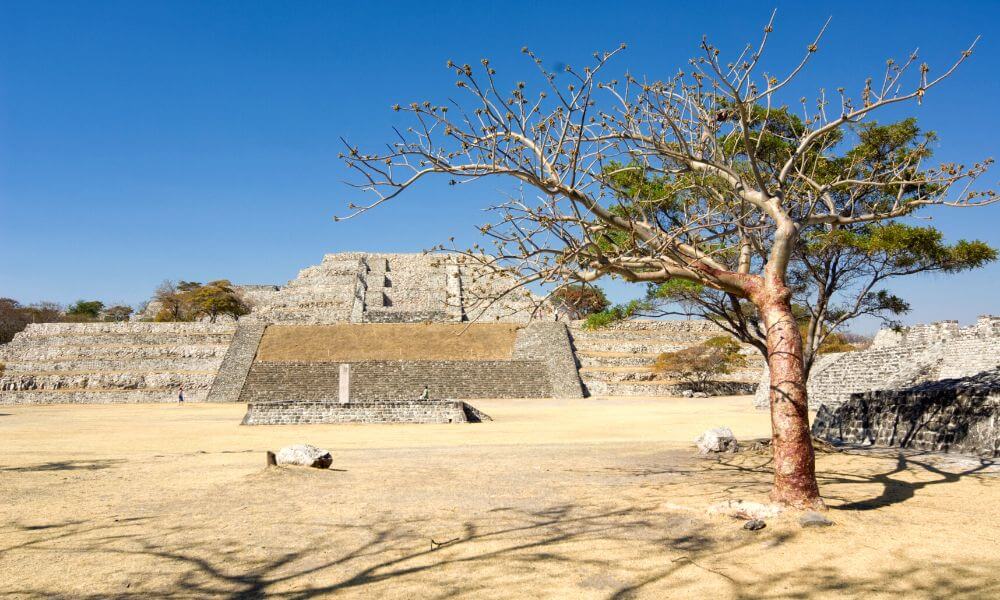
The Feathered Serpent Pyramid at Xochicalco holds a unique position among the pyramids of Mexico, owing to its distinct history, architectural complexity, and its status as a UNESCO World Heritage site.
Xochicalco flourished as a fortified pre-Hispanic capital city from 650 to 900 CE. It was one of the few fortified city-states that rose after the fall of biggies like Teotihuacan, Palenque, and Tikal.
Evidence suggests that a group of Mayan traders called the Olmeca-Xicalanca founded Xochicalco on a series of hills in Morelos. This provided excellent military protection as well as gave Xochicalo a strategic advantage in trade.
The Feathered Serpent Pyramid is one of the key structures within the site, known for its intricate carvings of the winged deity called Quetzalcoatl, an important figure across various Mesoamerican cultures. The carvings show a clear influence of both Teotihuacan and Mayan art.
Other highlights include ball courts, residential buildings, palace ruins, kitchens, workshops, as well as a traditional Mexican temazcal or sweat bath.
How to get to Xochicalco Pyramid in Mexico
Xochicalco is just 2 hours south of Mexico City. The fastest way to get to Xochicalco is to drive. You could rent a car, or hire a taxi for the day.
If you prefer public transport, take a bus from the Terminal del Sur in Mexico City to Cuernavaca, which takes around 1 to 1.5 hours. From Cuernavaca, local buses run regularly to Xochicalco.
Fascinating Pyramids of Monte Alban in Oaxaca
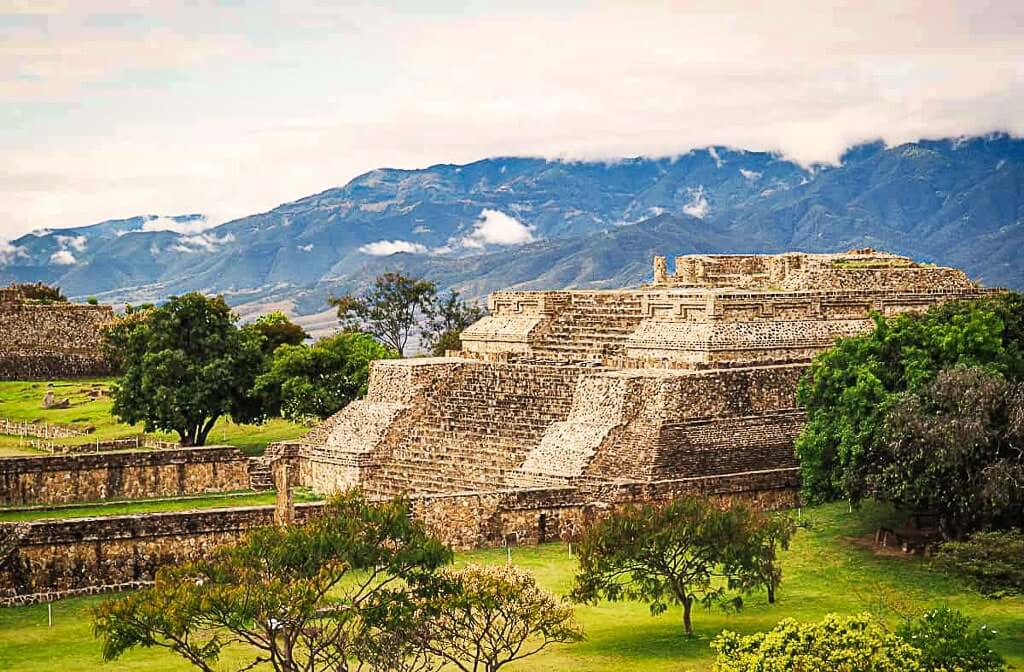
Monte Alban, nestled in the Southern Mexican state of Oaxaca, is home to some of the most fascinating pyramids in Mexico.
This ancient city, perched high above the Oaxaca Valley, was the political and economic center of the Zapotec civilization for over a thousand years, from about 500 BCE to 800 CE.
The pyramids of Monte Alban, recognized by UNESCO as a World Heritage Site, present an impressive sight with their grand architecture and rich cultural history. Numerous terraces, patios, and pyramids dot the sprawling ancient city.
The magnificence of the Great Plaza, the main ceremonial center, is a testament to the advanced architectural skills of the Zapotec people. The Plaza is surrounded by platforms, pyramids, and a sophisticated system of terraces that tell tales of the city’s historic urban planning.
The pyramids of Monte Alban are unique. They are staggered on artificial terraces and crowned with temples that were once used for religious rites and astronomical observations.
Don’t miss the danzantes or the dancers’ stones featuring intricate Zapotec carvings. They probably represent sacrificial victims.
A visit to Monte Alban offers a glimpse into the rich culture and impressive architectural feats of the lesser-known Zapotec civilization.
Getting to Monte Alban Pyramids in Mexico
Monte Alban is just 20 minutes from Oaxaca by car. You can hire a taxi that’ll take you directly to Monte Alban. Or book a Monte Alban guided tour that’ll give you an immersive experience of the ruins and the Zapotec culture.
If you’re comfortable with public transport, grab a local bus to Monte Alban from the Oaxaca City Center.
Tula Pyramids

Tula, the ancient capital of the Toltec civilization, is home to one of the most striking pyramid complexes in Mexico. The city of Tula rose to prominence between 800 CE and 1100 CE, during the post-classic period of Mesoamerican chronology.
These pyramids hold a unique status among Mexican pyramids due to the monolithic statues known as Atlantean figures or “Atlantes” atop Pyramid B or the Pyramid of Quetzalcoatl.
Standing over four meters tall, these stone warriors armed with an assortment of weaponry once bore the weight of the temple roof. The carefully carved details on these warriors, from their butterfly breastplates to their feathered headdresses, display the remarkable artistry of the Toltecs.
Other highlights include two more temple pyramids, a burnt palace complex, and the Coatepantli or Serpent Wall – a low-relief carved wall depicting serpents devouring skeletal figures.
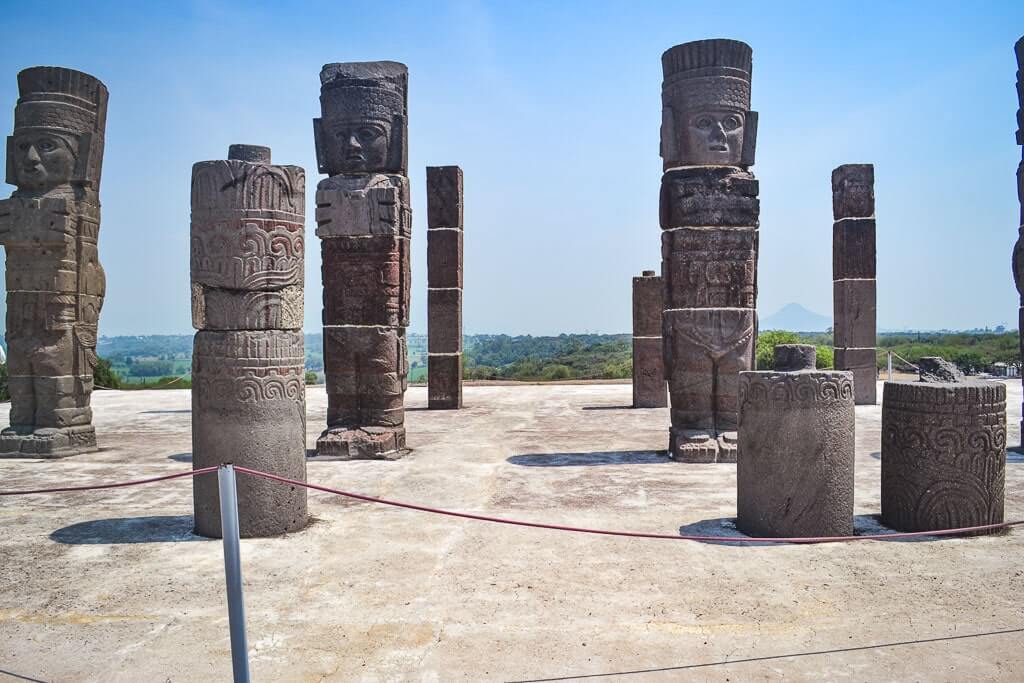
Getting to Tula Pyramids in Mexico
Tula is located about 50 miles north of Mexico City, which makes it a perfect day trip from CDMX.
There are regular buses from Mexico City’s Central del Norte bus station to Tula. The bus journey takes approximately 2 hours.
If you prefer a guided experience, many tour companies offer day trips to Tula from Mexico City. These tours often include transportation, a guide, and a visit to the Tula archaeological site. Here’s a highly-recommended full-day tour from Mexico City that includes the ancient ruins of Tula and the magical town of Tepotzotlan.
✦ Pro Tip: Visiting the ruins of Tula? Check out our complete visitor’s guide for the Tula archeological site.
Cañada de la Virgen Pyramid
The Cañada de la Virgen Pyramid is another one of Mexico’s never-ending pyramids that’s been off the radar most of the time.
Located just 15 miles west of the beautiful colonial town of San Miguel de Allende, this pyramid complex was built by the indigenous Otomi people around 300 CE and was in use until about 1050 CE.

The Otomi people were skilled astronomers, and they constructed this pyramid complex to align with significant celestial events, such as the rising and setting of the Moon and Venus.
As you explore the site, you’ll see multiple structures, including the House of the Wind, the House of the Thirteen Heavens, and the House of the Longest Night.
The most prominent is the House of the Thirteen Heavens which is the tallest pyramid on site. Recent research tells us that this pyramid was built solely to keep time!
What’s interesting about Cañada de la Virgen is that this is probably the only archeological site in Mexico that’s located on private property in an ex-hacienda! So, you need to be accompanied by a tour guide to see it.
Getting to Cañada de la Virgen
The best way to get to Cañada de la Virgen is to opt for a guided tour from San Miguel de Allende since you need a guide to explore the site anyway. Here are two popular tours from San Miguel de Allende that include round-trip transportation from the city.
Mexico Pyramids FAQ
Mexico’s pyramids are spread all over the country with a majority of the Aztec pyramids located in and around Mexico City and Mayan pyramids in the Yucatan Peninsula. The rest built by other pre-Hispanic civilizations are scattered in between.
People of ancient Mesoamerican civilizations such as the Mayans, the Aztecs, the Olmecs, the Toltecs, the Totonacs, and the Zapotecs built the Mexican pyramids.
Unlike the pyramids of Egypt which were used as funerary chambers, the pyramids in Mexico were used as temples for Mesoamerican deities. Several of them were dedicated to Quetzalcoatl, the Winged Serpent God of ancient pre-Hispanic cultures.
The pyramids in Mexico are called templo (temple in Spanish) because they are usually shrines dedicated to indigenous deities.
Loved our Mexico Pyramids Bucket List? Pin it for later!



